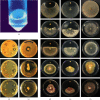Discovery of a Novel Lineage Burkholderia cepacia ST 1870 Endophytically Isolated from Medicinal Polygala paniculata Which Shows Potent In Vitro Antileishmanial and Antimicrobial Effects
- PMID: 33679984
- PMCID: PMC7904367
- DOI: 10.1155/2021/6618559
Discovery of a Novel Lineage Burkholderia cepacia ST 1870 Endophytically Isolated from Medicinal Polygala paniculata Which Shows Potent In Vitro Antileishmanial and Antimicrobial Effects
Abstract
In this study, we report the isolation and identification of an endophytic strain of Burkholderia cepacia (COPS strain) associated with Polygala paniculata roots. Polygala plants are rich sources of promising microbiomes, of which the literature reports several pharmacological effects, such as trypanocidal, antinociceptive, anesthetic, anxiolytics, and anticonvulsant activities. B. cepacia COPS belongs to a new sequence type (ST 1870) and harbors a genome estimated in 8.3 Mbp which exhibits the aminoglycosides and beta-lactams resistance genes aph(3')-IIa and bla TEM-116, respectively. Analysis performed using MLST, average nucleotide identity, and digital DNA-DNA hybridization support its species-level identification and reveals its novel housekeeping genes alleles gyrB, lepA, and phaC. The root endophyte B. cepacia COPS drew our attention from a group of 14 bacterial isolates during the primary screening for being potentially active against Staphylococcus aureus ATCC 29213, Enterococcus faecalis ATCC 29212, Micrococcus luteus ATCC 9341, Escherichia coli ATCC 25922, and Candida albicans ATCC 10231 and exhibited the broad-spectrum activity against phytopathogenic fungi. In addition, COPS strain showed production of protease, lipase, and esterase in solid media, and its natural product extract showed potent inhibition against fungal plant pathogens, such as Moniliophthora perniciosa, whose antagonism index (89.32%) exceeded the positive control (74.17%), whereas Sclerotinia sclerotiorum and Ceratocystis paradoxa showed high percentages of inhibition (85.53% and 82.69%, respectively). COPS crude extract also significantly inhibited S. epidermidis ATCC 35984, E. faecium ATCC 700221 (MIC values of 32 μg/mL for both), E. faecalis ATCC 29212 (64 μg/mL), and S. aureus ATCC 25923 (128 μg/mL). We observed moderate antagonistic activity against A. baumannii ATCC 19606 and E. coli ATCC 25922 (both at 512 μg/mL), as well as potent cytotoxic effects on Leishmania infantum and Leishmania major promastigote forms with 78.25% and 57.30% inhibition. In conclusion, this study presents for the first time the isolation of an endophytic B. cepacia strain associated with P. paniculata and enough evidence that these plants may be considered a rich source of microbes for the fight against neglected diseases.
Copyright © 2021 Felipe de Paula Nogueira Cruz et al.
Conflict of interest statement
The authors declare that they have no conflicts of interest.
Figures




Similar articles
-
Antimicrobial and anti-Quorum Sensing activities of selected medicinal plants of Ethiopia: Implication for development of potent antimicrobial agents.BMC Microbiol. 2016 Jul 11;16(1):139. doi: 10.1186/s12866-016-0765-9. BMC Microbiol. 2016. PMID: 27400878 Free PMC article.
-
Effect of Ottoman Viper (Montivipera xanthina (Gray, 1849)) Venom on Various Cancer Cells and on Microorganisms.Cytotechnology. 2014 Jan;66(1):87-94. doi: 10.1007/s10616-013-9540-z. Epub 2013 Feb 5. Cytotechnology. 2014. PMID: 23381026 Free PMC article.
-
Antituberculotic activity of actinobacteria isolated from the rare habitats.Lett Appl Microbiol. 2017 Sep;65(3):256-264. doi: 10.1111/lam.12773. Lett Appl Microbiol. 2017. PMID: 28699251
-
Antimicrobial activity of endophytic fungi from the medicinal plants Mammea americana (Calophyllaceae) and Moringa oleifera (Moringaceae).Biomedica. 2020 Mar 1;40(1):55-71. doi: 10.7705/biomedica.4644. Biomedica. 2020. PMID: 32220164 Free PMC article. English, Spanish.
-
Chemical constituents of Helichrysum italicum (Roth) G. Don essential oil and their antimicrobial activity against Gram-positive and Gram-negative bacteria, filamentous fungi and Candida albicans.Saudi Pharm J. 2017 Jul;25(5):780-787. doi: 10.1016/j.jsps.2016.11.001. Epub 2016 Nov 12. Saudi Pharm J. 2017. PMID: 28725151 Free PMC article.
Cited by
-
Bioactive potentiality of secondary metabolites from endophytic bacteria against SARS-COV-2: An in-silico approach.PLoS One. 2022 Aug 4;17(8):e0269962. doi: 10.1371/journal.pone.0269962. eCollection 2022. PLoS One. 2022. PMID: 35925905 Free PMC article.
-
Impact of template denaturation prior to whole genome amplification on gene detection in high GC-content species, Burkholderia mallei and B. pseudomallei.BMC Res Notes. 2024 Mar 12;17(1):70. doi: 10.1186/s13104-024-06717-8. BMC Res Notes. 2024. PMID: 38475810 Free PMC article.
-
Community Structure and Diversity of Endophytic Fungi in Cultivated Polygala crotalarioides at Two Different Growth Stages Based on Culture-Independent and Culture-Based Methods.J Fungi (Basel). 2024 Mar 4;10(3):195. doi: 10.3390/jof10030195. J Fungi (Basel). 2024. PMID: 38535204 Free PMC article.
-
Draft genome sequence of Bacillus velezensis endophytically isolated from roots of Polygala paniculata.Microbiol Resour Announc. 2024 Oct 10;13(10):e0082624. doi: 10.1128/mra.00826-24. Epub 2024 Sep 16. Microbiol Resour Announc. 2024. PMID: 39283091 Free PMC article.
References
LinkOut - more resources
Full Text Sources
Other Literature Sources
Molecular Biology Databases
Miscellaneous

